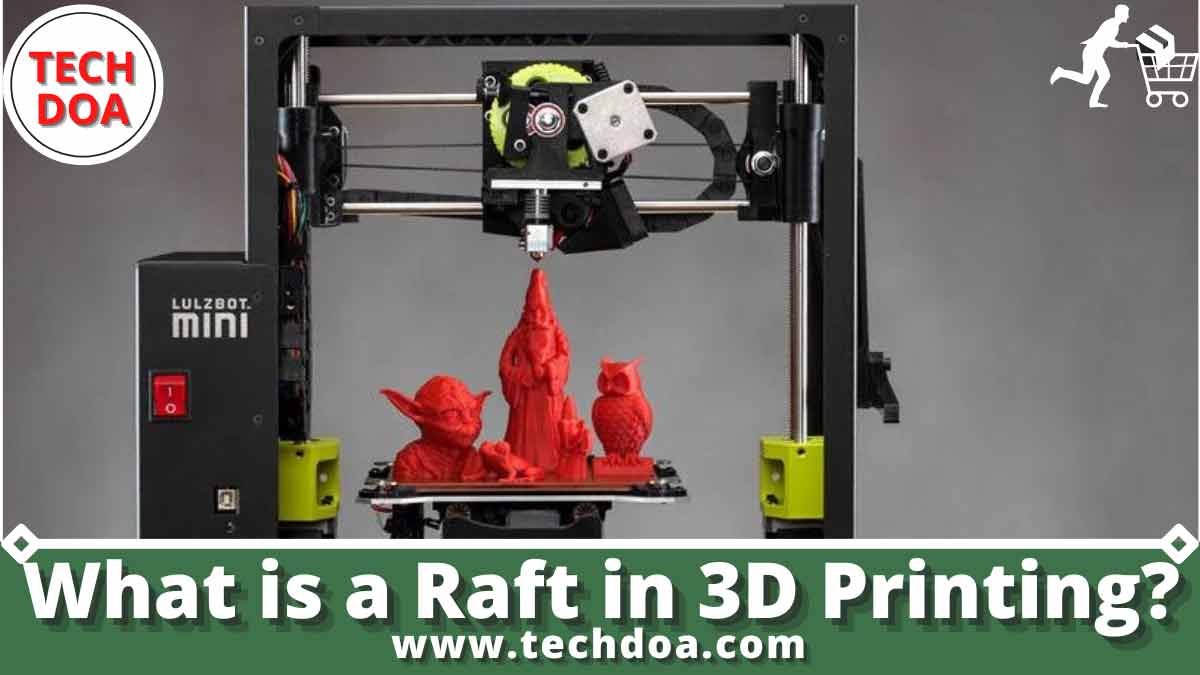A raft is a flat base that is used to support an object during the 3D printing process. The object being printed is placed on the raft and held in place by adhesive. Rafts are necessary when printing with certain materials, such as ABS plastic, that have a tendency to warp or curl during the cooling process. Warping can cause the object to detach from the build platform, which can ruin the print. A raft is a platform that helps to support a 3D printed object as it is being built. It can be made out of many different materials, but is typically made out of the same material as the object being printed. The raft helps to keep the object from warping or moving during the printing process, and can be easily removed once the print is complete. In this article we will discuss about what is a raft in 3d printing?
What is a Raft in 3D Printing?
Raft and brim are two methods used in 3D printing to improve the adhesion of the print to the build surface and prevent warping. Raft is a method where a grid of small lines is printed around the perimeter and infill of the object. This creates a larger surface area for the object to adhere to, which prevents it from warping or lifting off the build plate. Brim is similar to raft, but instead of a grid, a single layer of lines is printed around the perimeter of the object. This also creates a larger surface area for adhesion, but does not add as much stability as raft.
What is a Raft in Cura?
In Cura, a raft is a type of support structure that is added to the bottom of a model to help it adhere to the build plate and prevent warping. Rafts are typically made up of a grid of lines or circles and can be customized to fit the geometry of the model.
What is Brim in 3D Printing?
3D printing, also known as additive manufacturing, is a process of making three-dimensional solid objects from a digital file. The creation of a 3D printed object is achieved using additive processes, where successive layers of material are laid down in different shapes. 3D printing is the opposite of subtractive manufacturing, which involves taking away material to create an object. 3D printing enables you to create complex shapes that would otherwise be impossible to produce through traditional manufacturing methods.
It also allows for the creation of customized objects quickly and cheaply. And because there is no need for expensive tooling or molds, 3D printing is often more cost effective than other manufacturing processes. Brims are one type of support that can be used in 3D printing. Brims are essentially flat surfaces that are added to the base of an object to help it adhere better to the build platform during printing. Brims also help improve print quality by providing additional stability and preventing warping.
How And When To Use Skirts, Brims, And Rafts For 3d Printing?
Raft Vs Brim 3D Printing
3D printing has come a long way in recent years, and there are now two main types of 3D printing technology: FDM (fused deposition modeling) and SLA (stereolithography). Both have their own advantages and disadvantages, but which one is right for your project? In this article, we’ll compare FDM vs SLA 3D printing, so you can make an informed decision about which technology is right for you. FDM 3D Printing FDM 3D printers work by extruding melted plastic filament through a nozzle to build up layers of material.
This process is relatively fast and inexpensive, making FDM ideal for prototyping and small-scale production runs. However, FDM prints can be less precise than those made with other technologies such as SLA. Additionally, the range of materials that can be printed with FDM is somewhat limited. But overall, FDM remains a popular choice for many projects due to its affordability and speed. SLA 3D Printing SLA 3D printers use a laser to cure resin into the desired shape. This process results in very accurate prints with smooth surfaces.
However, it can be slower than FDM and more expensive – making it better suited for low-volume production runs or highly detailed prototypes.
Can 3D Print Without Raft?
3D printing technology has come a long way in recent years, and one of the most notable advancements is the ability to print without using a raft. A raft is essentially a base that helps to support the object being printed, but it can add significant time and cost to the printing process. So, if you don’t need a raft, why use one? There are a few reasons why you might still want to use a raft even if your 3D printer is capable of printing without one. First, if your object is particularly large or complex, it can help to ensure that it prints correctly. .
Second, if you’re printing with ABS plastic (which tends to warp when heated), using a raft can help keep your object from distorting. Finally, some people simply prefer the look of objects that are printed with a raft – it can give them a cleaner appearance. Ultimately, whether or not you use araft when 3D printing is up to you. If you don’t need one, feel free to save time and money by skipping it!
3D Printing Skirt
3D printing is a type of additive manufacturing that can create three-dimensional objects by successively adding material layer by layer. Unlike traditional machining processes, 3D printing does not require the use of any tooling or molds. This makes it an ideal technology for creating customized parts and prototypes quickly and affordably. One of the most popular applications for 3D printing is fashion. Skirts are a particularly popular item to print due to their complex shape and relatively small size. 3D printed skirts can be made in a variety of styles, colors, and sizes to fit any body type.
The benefits of 3D printed skirts include the ability to try on multiple designs before settling on a final product, as well as the ability to make customizations such as lengthening or shortening the hemline. Additionally, 3D printed skirts can be made from a variety of materials including plastic, metal, and even glass. This gives designers unprecedented freedom when it comes to creating unique looks. If you’re interested in trying out a 3D printed skirt for yourself, there are plenty of online retailers that offer them for sale. Or if you’re feeling adventurous, you can even design and print your own using one of the many available CAD programs.
3D Printing Raft Vs Brim Vs Skirt
When it comes to 3D printing, there are three different types of support structures that can be used: rafts, brims, and skirts. Each one has its own advantages and disadvantages, so it’s important to choose the right one for your project. Rafts are the most commonly used type of support structure. They’re easy to remove, and they provide a good amount of support for your print. However, they can also make your print weaker and more likely to warp. Brims are similar to rafts, but they’re wider and provide more support around the edges of your print.
This makes them ideal for prints that are likely to warp or have small details that need extra support. However, brims can be more difficult to remove than rafts. Skirts are the least common type of support structure. They don’t provide as much support as rafts or brims, but they’re easier to remove. Skirts are typically used on large prints where warping isn’t a concern.
Conclusion
Rafts are an important part of 3D printing. They provide a base for your object to be printed on and help with adhesion. Without a raft, your object would likely not adhere to the build plate and would be ruined. Rafts also help to prevent warping and curling, which can ruin your print. So here we tried to know you what is a raft in 3d printing? I hope this guide will be helpful for you.

Senior Editor at Techdoa.com. With a great experience after using multiple printers, I review best printers with proper guideline. I hope my provided information will inspire you to choose the best printer for your personal or professional work.
